How Do You Know Turkey Is Done
How to cook a turkey? Don't waste your time with other posts. Hither'south the plain truth: The secret to perfect turkey is proper command of turkey temperature . And that's our jam. Use whatever recipe yous similar—deep-fry information technology, smoke it, roast it, whatever. Just neglect these cardinal principles at your own peril!
Turkey Doneness Temperature
Turkey Doneness Temp: 157°F (69°C) in the breast— not 165°F !, and 175°F (79°C) in the thigh for moist turkey. (USDA charts here or read more below to see why this is safe.)
How to Cook a Turkey at a Glance: Cooking Fourth dimension and More
- Thawing: You need to verify that your turkey is fully thawed before putting information technology in the oven or smoker or frier to avert disaster. Best thaw method is in the refrigerator—1 mean solar day per five lbs.
- Internal Temp Tracking: Track internal turkey temps while roasting, if you tin can. Place an alarm thermometer probe in the thickest role of the chest (another in the thigh).
- Oven Temps: Best roasting is two stage process—450°F (232°C) for 1 60 minutes, then downwardly to 325°F (163°C) for even so long information technology takes until the turkey is done. If you read a mail telling you exactly "how long to melt a turkey," hit the back button fast.
- Verify Turkey Doneness: Be sure to verify your doneness temps with an instant-read thermometer. The everyman reading you find should be 157°F (69°C) in the chest or put it back in the oven or smoker a piddling longer.
How to Cook a Turkey In Depth: Everything You Demand to Know…
No other holiday has such a laser focus on a single piece of food—the Thanksgiving Turkey. If the turkey isn't right, the day gets an asterisk. If the turkey is just perfect, everyone somehow feels more thankful. To say nothing about the real danger of nutrient poisoning with poultry! And YET, how often practise you lot melt a whole turkey during the other 364 days of the year? Perchance at Christmas? Maybe never? Cooking a perfect Thanksgiving Turkeyon cue is a footling like beingness called in to throw the winning touchdown when you haven't touched a football game all year. Just don't worry. We've got you lot covered.
Now that you've reviewed the "at a glance" headlines, information technology's time to dig a footling deeper. Let's first with some of the virtually common questions…
HOW LONG TO COOK A TURKEY?
Perhaps the question people ask most well-nigh cooking a turkey is "how long it is going to have?" Charts and posts about turkey cooking times grow promising "Turkey Cook Times," just they all share the aforementioned fundamental flaw—no chart can take into business relationship all the variables that can really affect your particular turkey'southward actual cooking time…
Things that Change Rate of Cooking…
- The accuracy of your oven or smoker (most ovens are off their fix point past 25-50°F [fourteen-28°C])
- The type of oven (conventional, convection)
- Uneven heating menstruum in your oven
- Where the turkey is positioned in the oven or smoker
- The depth and size of the pan
- The type of roasting pan: whether it's dark, shiny, or boring
- Using a roasting pan with a lid (don't practise this BTW)
- The exact size of your turkey
- Information technology's shape dimensions relative to other turkeys
- The fatty content of your turkey
- How warm it was when it went into the oven or smoker
- Whether it was completely thawed or however partially frozen
- Whether information technology was tented with foil or not
- Whether it is blimp or unstuffed
So, can y'all trust a turkey time chart to make certain your turkey is a) done enough to be safe to eat or b) not dry and tasteless? No, you lot cannot. Time charts exercise have their use. They help you lot judge when to beginning cooking your turkey relative to dinner time. Simply for succulent turkey, you want to cook your turkey until information technology is done and not a moment longer.
WHAT TEMPERATURE IS TURKEY Done?
Click on nearly any other "how to cook a turkey" post and yous'll come across the aforementioned bad information repeated over and over. Only despite what they all say, yous absolutely should Non melt your turkey breast meat to 165°F (74°C) or to—sky forbid—180°F (82°C)!
Our answer? Melt the chest meat to 157°F (69°C) for moist, juicy turkey.
Bone dry turkey white meat is the reason then many people kind of detest turkey. It's also why turkey gravy and cranberry sauce are de rigueur on then many Thanksgiving dinner tables. Simply if you've ever eaten properly cooked turkey white meat, you know it can be moist and absolutely delicious without whatsoever added condiment!
2 Different TYPES OF MEAT
Part of the challenge hither is that a whole turkey actually has 2 very unlike types of meat on the same bird: the lean and tender white meat of the chest and the heavily worked dark meat of the legs and thighs. Cooking them at the same time is a picayune like trying to cook a steak and a brisket in the same oven. Since the dark meat, similar a brisket, needs higher temperatures for the collagen to melt, our recommendation for the tender nighttime meat is 175-180°F (79-82°C)! (Read more hither about how to achieve both temps in the same bird.)
IS It SAFE TO Swallow?
The other challenge is that people misinterpret the nutrient rubber tables put out by the USDA. Achieving a reduction of the poultry pathogen Salmonella is a role of both time and temperature. Note this screenshot from the USDA'south own tables on turkey safe…
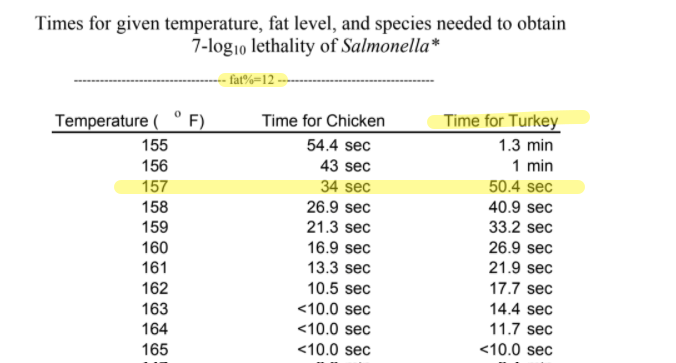
This shows that a turkey held at 157°F (69°C) for fifty.4 seconds will achieve the same lethality on Salmonella as a turkey cooked to 165°F (74°C) does instantaneously. And what are the odds that a turkey pulled at 157°F (69°C) will remain at that temp for at least a minute? 100% because of something chosen Carryover Cooking. The temperature is actually guaranteed to proceed going upwards for a spell subsequently yous remove it from the oven or smoker.
Meanwhile the white meat in turkey will start to miscarry its h2o in the 150'southward F (sixty'southward C) and be bone dry past the time it reaches 165°F (74°C).
Do your family unit a favor this Thanksgiving. Pull your turkey from the oven or smoker at 157°F (69°C). Only remember to verify!
With those big questions out of the way, let's get down to contumely tacks. Here's the best advice you'll find on how to melt an amazing turkey. Information technology starts right up front with the thaw…
PART 1: HOW TO THAW A TURKEY
It'southward oftentimes disregarded but the kickoff key to delicious turkey is proper thawing. You tin actually melt a fully frozen turkey and, of class, you tin cook a fully thawed turkey. But cooking a turkey that ispartially thawed and partially frozen on Thanksgiving morning is a recipe for disaster.
A partially frozen turkey will cook unevenly. By the time the inner frozen surface area thaws and comes to its pull temperature, the outermost layers of the turkey will be woefully overcooked.
THE BEST METHOD: HOW TO DEFROST A TURKEY IN THE FRIDGE
The best way to get an evenly thawed turkey is the ho-hum and gentle way. Information technology takes a little forethought and making some room in your fridge but is the easiest method, also.
Steps
1.
Put your frozen turkeybreast-side Upwards on a rimmed canvas pan or tray in your refrigerator set to37°F (3°C).
2.
Allow at least24 hours for every 5-6 pounds (2.3–2.7 kg) of frozen turkey. A xx-pound (ix.1 kg) turkey will take 4 full days to thaw in a fridge.
TURKEY THAW DAY
For near all turkey sizes, the Sat before Thanksgiving is the perfect day to identify your frozen turkey in the refrigerator—allowing enough of time for thawing without letting the thawed turkey overstay it'southward welcome in the refrigerator earlier cooking. So mark "Turkey Thaw Day" on your calendar at present!
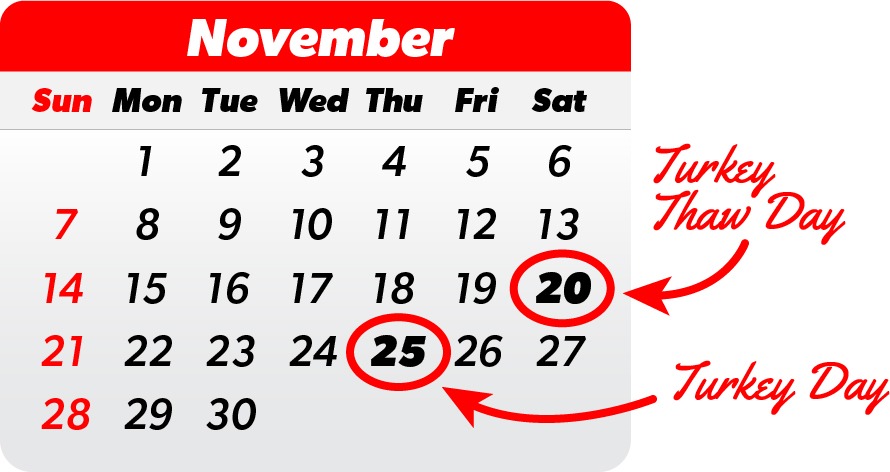
SPEED THAW METHOD
If you lot don't take several days at your disposal, you can attempt thespeed method.
Water has a much greater molecular density than air. Heat transfer from the molecularly dense water to the frozen turkey happens much faster than in air. You volition demand to let at least 30 minutes per pound(per .45 kg), so information technology will still accept some time.
Steps
i.
Identify your unopened turkey (it must be in airtight wrapping)breast-side Down in a cooler and fill with cold water to cover. Your turkey may bladder at first, that'south okay. Information technology volition begin to sink as it thaws.
2.
Use an warning thermometer like the ChefAlarm ® with its high alarm gear up to41°F (4.5°C) to track the water temperature during a water thaw. (If you like, you lot can also take reward of the ChefAlarm's born timer to go on rail of your hours.) Or spot-check the h2o'southward temperature every half hour with an instant-read thermometer like a Thermapen, and add water ice to keep the water atforty°F (4.4°C) or below. This is very important! If the water gets above 40°F (4.4°C) while the turkey is thawing, bacteria may begin to grow that could survive the cook.
This process may require 1-2 large bags of ice—and so be prepared.
VERIFYING THAT YOUR TURKEY IS THAWED
Whichever method you lot apply, you should ALWAYS verify that the internal temperature of your turkey is above freezing BEFORE putting information technology in the oven or smoker. Once again, you lot tin actually cook a frozen turkey and, of course, you can cook a thawed turkey, but you can't cook a partially thawed, partially frozen turkey. If the center of the turkey is withal frozen, past the time it comes to a food rubber temperature, the outside meat will be burned to a crisp.
Steps
1.
Using a fast and authentic instant-read thermometer, like Thermapen ONE, push the probe tip through the wrapper, deep into the breast and pull it out noting the temperature reading every bit information technology changes. The lowest temperature you meet should exist xxx°F (-1°C) or to a higher place (and, of course, below the danger zone— 40°F [four.four°C]). Check in several places. Check deep in the thigh and next to the neck cavity too.
2.
If you encounter water ice with the probe, or see a temperature reading below xxx°F (-1°C), continue thawing using either method higher up until the turkey is fully thawed.
PART 2: PREP YOUR TURKEY Peel FOR THE OVEN OR SMOKER
One of the most delicious parts of a properly cooked turkey is crispy skin. And crispy skin after cooking starts with DRY skin before cooking. H2o on the surface of the meat will slow down the cook, and cause uneven browning. The heat of the oven or smoker must first work to evaporate the surface moisture before the cooking actually begins.
So, prep your turkey skin by either drying or, better all the same, dry out brining your turkey skin before cooking.
Steps
one.
Pat your turkey dry out with paper towels correct earlier cooking. (This is specially important if yous wet-brined your turkey in saltwater). Be sure to get the entire surface of the turkey (even the within surface of the primary crenel and neck crenel)nice and dry earlier seasoning.
two.
Slather on the butter or oil and spices (whatever your recipe calls for) and beginning cooking.
3.
Optionally, get fifty-fifty crispier skin and juicier, more flavorful turkey meat by dry-brining your bird. Dry brining is essentially air-drying your turkey. After applying your spices (we prefer just plain salt and pepper), leave youruncovered in the refrigerator on a blistering tray for the morn (eight hours) before or the entire mean solar day before (24 hours) cooking your turkey.
Part iii: TRACKING YOUR TURKEY'S INTERNAL TEMPERATURE
TWO THERMOMETERS ARE Ameliorate THAN Ane
The more uniform a slice of meat is in shape and size, the more than evenly it will cook. (This is why we tie up roasts and butterfly some cuts of meat before cooking them.) Needless to say, whole turkeys are anything merely uniform in shape! The breasts are thick at one end and tapered toward the other, while the legs are quite a bit smaller. These different areas of the turkey just will not cook at the same rate.
That'south why it's important both to track your cooking temp with a cooking alarm thermometer like Smoke X, ChefAlarm, or DOT (sometimes called a "leave-in probe thermometer" or an "oven thermometer") and to verify your doneness temps with a fast and accurate instant-read thermometer. Two dissimilar thermometers for two unlike but very important jobs.
If you only have one, the instant-read is the more than of import, since it allows you to verify doneness temperature in multiple places. Merely each time you lot open the oven door or the smoker hat to check on your turkey temps, you lot're probable to reduce the internal temperature of the oven or smoker by as much as 50°F (28°C). Each fourth dimension!
But with an alarm thermometer, you'll exist able to runway your turkey'south internal cooking temperature from outside the oven or smoker, so you won't miss the critical moment when your turkey is done!
Retrieve, your goal is to cook your turkey breast to exactly 157°F (69°C) and not one degree more before removing it from the oven, smoker, or frier.
PART 4: WHERE TO PLACE THE THERMOMETER PROBE
Most "How to Cook Turkey" posts show the thermometer sticking direct up out of the breast of the turkey, simply that is a bad thought. The "gradients" or different temperatures in a turkey breast while information technology cooks follow the contours of the chest itself, which are long and apartment (picture a craven breast).
Pushing a probe vertically through the top means yous are cutting across those gradients. That's the right way to verify the doneness of the bird, just for temperature tracking, nosotros recommend increasing the likelihood that you position the probe sensor in the "thermal center" of the breast by following its contours and inserting the probe horizontally, parallel to the baking tray.
Steps
1.
Hold the probe confronting the turkey chest to approximate how securely you should push the probe tip into the breast to reach its center. With your other paw, compression about where you recollect the probe will reach the outer border of the turkey.
2.
Insert the probe laterally, from virtually the neck cavity, parallel to the cut lath or pan upwards to your fingers pinching the probe with your other paw.
3.
The probe'southward tip should be about 1/2 to ane inch (1.three to 2.5 cm) from the internal cavity of the bird to avert touching the bone. Yous tin wiggle the probe tip within the turkey breast and feel with your other manus to verify information technology is almost the center of the chest.
4.
If you Do have a second probe to piece of work with, push it deep into the thigh—between the leg and the body of the turkey. If yous hit os, pull the probe tip back one-half an inch.
five.
Set up the alarm thermometers high warning to 157°F (69°C) in the chest. If y'all have a 2nd channel for a second probe in the thigh meat, set up its high alarm to 175°F (79°C).
With a cooking alarm thermometer you will exist able to track your turkey's internal temperature from your counter top! Avoid the temptation to open the oven or smoker, and let out the hot air, until the alarm sounds.
When the warning sounds, it's time to verify the doneness of your turkey.
Part 5: VERIFYING PULL TEMPS—HOW TO KNOW WHEN YOUR TURKEY IS REALLY Washed
The best way to know your turkey is done is, simply, to take its temperature. Yeah, you've been monitoring the temp with a leave-in probe thermometer, but there's a good chance that you didn't hit the thermal center with the tip of the probe, despite your best efforts. Verifying your turkey's temperature with an instant-read thermometer like the Thermapen ® ONE is crucial in making sure your bird is fully cooked.
HOW TO VERIFY YOUR TURKEY'S TEMPERATURE
When your alarm thermometer'due south loftier alarm sounds at157°F (69°C) in the breast, it'southward time to verify that its reading is the lowest temperature.
Remember, your turkey is just as done as thelowest internal temperature yous can find.
Steps
1.
Using a fast and accurate instant-read thermometer, similar a Thermapen 1, plunge the probe deep into the breast meat from the top and so pull the probe tip up slowly back through the turkey meat watching the thermometer display.
2.
Do this in at least 2 places in the breast. You're looking for a everyman-temperature reading of at least157°F (69°C) in the breast meat.
3.
If you encounter temperatures beneath157°F (69°C) in the breast, reposition of thealarm thermometer's probe until the reading on the alert thermometer matches the lowest reading y'all found on the instant-read (exist careful to utilise a hot pad on the hot probe). Return the turkey to the oven or smoker to proceed cooking until the alarm sounds again and 157°F (69°C) is the lowest temperature found in the breast.
four.
When the chest meat doneness temp is verified, go ahead and check your dark meat by pushing the probe tip of your instant-read thermometer deep into the thigh meat between the leg and the body of the turkey. Pull the probe tip upwardly slowly back through the thigh meat watching the thermometer brandish.
five.
The dark meat will will taste better at temperatures to a higher place175°F (79°C) merely is perfectly prophylactic to eat above165°F (74°C). (Read more about how to achieve higher temps in the dark meat while go along the breast meat tender.)
PART 6: Remainder YOUR TURKEY AFTER COOKING
Pulling your turkey from the oven or smoker or frier is really NOT the last stride earlier etching and serving. Resting your turkey is. We recommend a 30-minute rest before etching.
Why rest? Two important reasons…
1. CARRYOVER COOKING IN TURKEY
The college temperatures that exist on the exterior of the turkey will go along moving toward the lower temperature center area of the meat even after you have your turkey out of the heat.
This is called carryover cooking. While small cuts of meat similar steaks or chops feel minimal carryover, big cuts, similar turkeys or roasts, tin experience equally much as 5-x°F (3-6°C) increment in internal temperature while the outside cools. We call the mode a cooked turkey comes to ane temperature while it rests "equilibration."
two. REDISTRIBUTION OF EXPELLED JUICES
Some other reason to residual your turkey is then it has a chance to reabsorb its juices.
While exposed to the intense oestrus of an oven, smoker or fryer, turkey meat's protein fibers shorten, shrink and contract, expelling out the water they've retained. During the residual, these protein fibers have a chance to relax and reabsorb some of the juices that are lost. A turkey carved and served without resting will spill more than of its juices onto the cutting lath and non exist as moist.
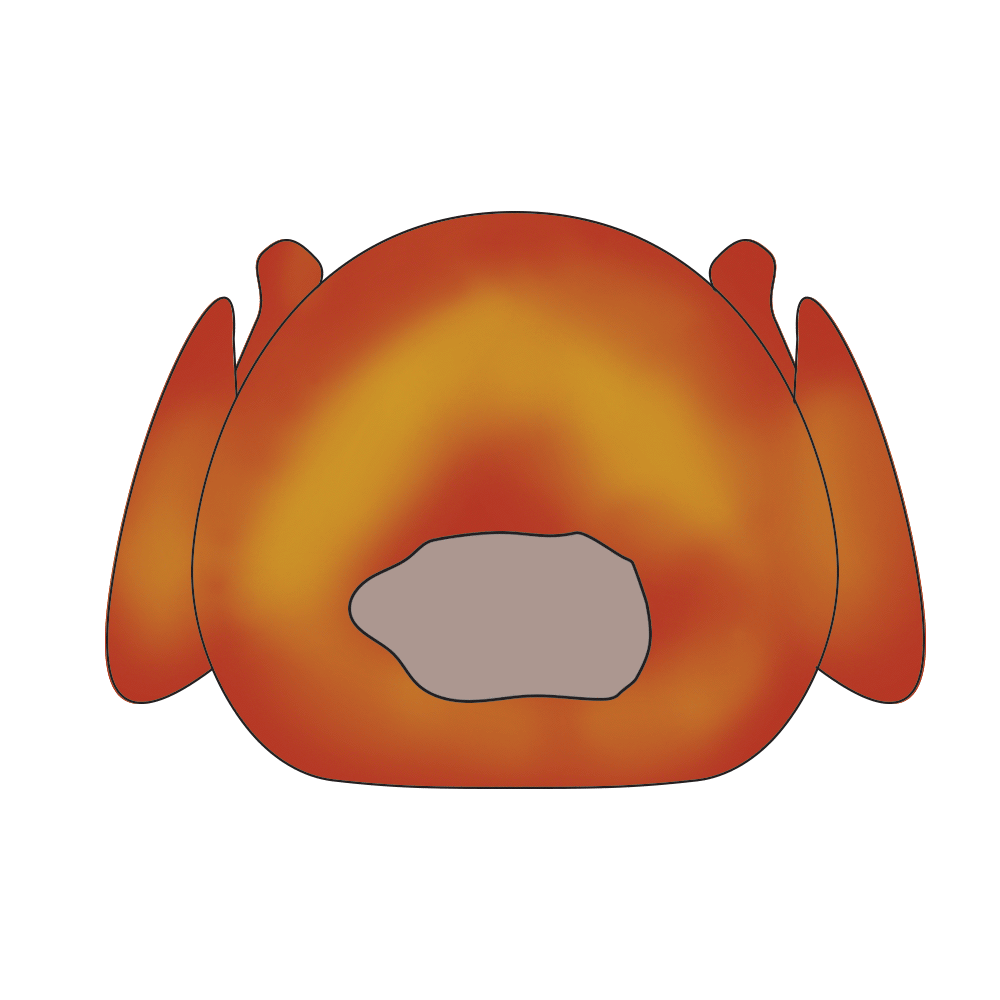
HOW TO Runway CARRYOVER COOKING DURING THE Residual
Steps
one.
Once you accept verified that your turkey has reached its pull temperature of157°F(69°C), remove the turkey from the oven or smoker.
two.
If y'all have a ChefAlarm or Smoke alarm thermometer from ThermoWorks, leave the probe in identify, and the alert thermometer will record the maximum temperature reached by the internal meat of the turkey during the rest.
three.
Set a timer for xxx minutes, and allow your turkey to rest at room temperature (the ChefAlarm has one built-in).
iv.
Check the ChefAlarm or Fume's Max temperature reading to run across what your turkey'southward final resting temperature was. Even if your turkey didn't reach165°F (74°C), it only needs to be held for 25.6 seconds at160°F (71°C) to accomplish the aforementioned level of food safety (a 7-log reduction in pathogens as defined past the USDA).
5.
If you want your turkey pare to stay crispy, keep the turkeyuncovered during the remainder. If you demand to concord the turkey for longer than one-half an hour earlier serving, keep information technology warm in an oven gear up to150°F (66°C). Leave your alert thermometer probe in place and runway the internal temperature while you wait.
APPENDIX one: TO GET It Correct, UNDERSTAND THESE 3 THINGS
1. TEMPERATURE GRADIENTS
While meat is cooking, estrus transfers from the outside in. Because of this, the outside of a turkey will be at a college temperature with lower temperatures as y'all move toward the heart of the meat. This departure in temperature between the exterior and interior of the meat is referred to equally a temperature slope .
When cooking anything,the college the temperature you cook at, the larger the temperature gradient within the meat. That is, turkey cooked at 450°F [232°C] will accept a larger band of overcooked meat around its edges than turkey cooked at 250°F [212°C].
—The Food Lab's Step-by-Step Guide to Smoking A Turkey, J. Kenji Lopez-Alt
Understanding temperature gradients leads right into the core of where to place your thermometer's probe. The thermal middle:
2. THERMAL CENTER
The thermal center is the point in the turkey furthest from the exterior of the meat that takes the longest to melt.
The largest mass of the turkey is its breast meat, and the deepest part of the chest in its thickest area is where the thermal center will exist. This lowest temperature is the one that needs to exist tracked during the melt becauseyour meat is only equally done and safe as the lowest temperature constitute.
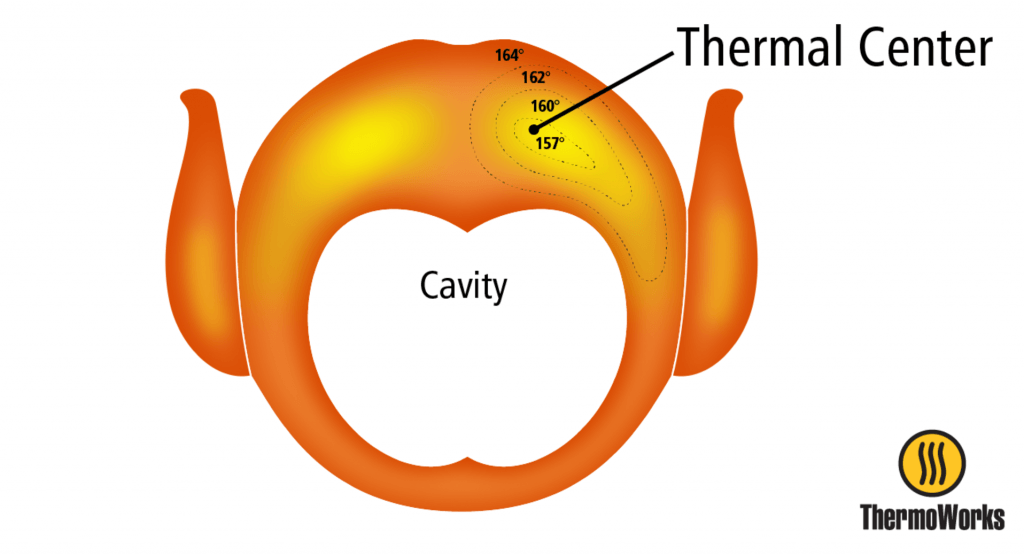
3. UNDERSTAND YOUR THERMOMETER'S PROBE
For themost authentic probe placement, information technology helps to know a thing or ii about your leave-in thermometer'south probe. You need the office of the thermometer that isactually taking the temperature to exist in the thermal heart. It'southward worth noting that this is physically impossible with an onetime-fashioned dial thermometer. The sensor in dial thermometers is an inch-long jump that averages temperatures over the lesser inch of the probe to take a reading. And the and then-called "popular-up thermometers" that come in some turkeys are only measuring the outer quarter inch of the breast!
But for a digital thermometer probe, like our industry-leading Pro-Series probes, the sensor that needs to exist in the thermal center is the tiny cone at the very tip of the probe.
With the sensor in such a pocket-size expanse, y'all tin pinpoint accurate readings from inside very small temperature gradients in the meat. But make certain your probe tip is in the thermal center!
APPENDIX 2: HOW TO Go HOTTER Dark MEAT THAN WHITE MEAT
To achieve the end goal of tender, juicy breast meat and silky, succulent nighttime meat, the internal temperature in the thighs needs to exist at least 175°F (79°C) by the time the breast meat reaches 157°F (69°C).
To help alleviate the challenge of cooking two completely different types of meat at the aforementioned time, chefs and food science experts have pushed different methods, including roasting the turkey upside downwardly, shielding the breasts with tin foil, or even separating the white meat from the nighttime meat and cooking them separately.
Just if yous want to keep the turkey whole, there are two methods that we have found stand up above the balance when it comes to the thermal principles at play that make or break turkey success.
Pick one: ICING THE BREASTS
This method, recommended by Harold McGee, gives the night meat a thermal head start earlier the turkey goes into the oven or smoker and it works like a charm. It may seem a bit alarming to get out the turkey out on the counter for a couple of hours before putting information technology in the oven or smoker, merely nutrient safety experts who know near the Temperature Danger Zone, know that food can safely residual betwixt 40 and lxx°F (4 and 21°C) for a full of 4 hours.
Steps
ane.
Fill two sandwich or quart-sized Ziploc bags (depending upon the size of the turkey) with water ice and clip them together at the elevation with a folder clip.
two.
Remove the turkey from the refrigerator and ready it on a baking tray on the counter. Balance the Ziploc bags over the breasts
3.
Fix a timer, similar the Extra Big & Loud, for two hours. When the timer goes off, remove the ice bags, properly place your probes and immediately put the turkey in the oven or smoker as usual.
four.
Optionally, one hour into your breast icing, place a ceramic pizza stone in the oven and preheat the oven to 500°F (260°C) for 1 hour to permit the pizza rock to blot heat. The hot pizza rock near the lesser of the turkey—where the legs and wings are—volition help maintain a temperature differential between the nighttime meat and light meat. When the terminal two-hr timer sounds, reduce the oven to 450°F (232°C) earlier putting the turkey in the oven.
5.
If you are able to track both the breast meat and the thigh meat temperatures while you are cooking, you should notice a expert x to xv°F differential (vi to viii°C) between the two that will track the whole style through the cook.
Option two: SPATCHCOCKING
Of all the turkey cooking methods, this i delivers the biggest dial, in our apprehensive opinion. If you've ever baked a pan of brownies you must take noticed how the brownies nigh the edge of the pan are fully cooked while the brownies in the center of the pan are still gooey.
Spatchcocking involves removing the courage of the turkey to allow it to exist flattened into a roasting tray and relies on the same principle to "fully melt" the dark meat on the outside of the tray while keeping the white meat in the cooler center.
Learn more about spatchcocking turkey here.
APPENDIX iii: Carving
Etching your turkey properly is the perfect finishing touch. Not just does it brand it easier for people to consume, just it is the perfect style to publicly demonstrate your new-plant turkey prowess! Only carving a turkey—with all its nooks and crannies, the legs, wings, and breasts on the ribcage—is non similar etching a tenderloin. Information technology takes a strategic programme.
To cleave your turkey…
Steps
one.
Remove the turkey leg past slicing down betwixt the thigh and chest. Pull the thigh abroad from the chest until the thigh pulls out of joint. Finish severing the articulation with the point of your knife until the entire leg is complimentary.
2.
Dissever the turkey drumstick from the thigh past following the line betwixt the leg and the thigh with the point of your knife. Once again, pull the drumstick away from the thigh to reveal the joint. End severing the articulation with the point of your pocketknife.
Do the same to the other thigh and drumstick.
three.
Costless the breast by cut down right next to the keel bone. Angle your knife outward and follow the bone structure downward of the bird all the way along the ribcage until the breast meat is costless. Starting at one tip, piece the breast meat into cross-sections, each with their own strip of peel.
Repeat on the other breast.
4.
Remove the wing past pulling the wing away from the carcass to identify the joint. Sever the joing with the point of your knife. Repeat for the other wing.
Conclusion
We hope that your Thanksgiving or holiday turkey is the best y'all've ever had! No matter your recipe, be sure to follow all these thermal guidelines to get the very best results this yr and again side by side year, besides. Skillful luck and happy cooking! And exist sure to let us know how YOUR turkey turned out below in the comments section…
Impress
Description
How to cook a turkey, the piece of cake, accurate way
- 1 turkey, thawed until no part of the bird is colder than 30°F (-ane°C)
- Kosher salt
- Black pepper
- Oil or rendered fat
The day earlier you melt the turkey—dry alkali: optional but highly recommended.
- Unwrap the turkey and remove the neck and giblets, if nowadays.
- Place the turkey on a rack set in a rimmed baking tray.
- Liberally glaze the skin of the turkey with kosher common salt and season it with pepper.
- Identify the turkey, unwrapped, in the refrigerator on the bottom shelf. Let it sit overnight.
The 24-hour interval of the cook
- Preheat oven to 425°F (218°C)
- Dry the peel with paper towels if it is damp, or if you didn't dry brine it.
- Rub the peel well with oil or rendered fatty.
- Place a handful of aromatics in the cavity of the turkey.
- If yous didn't dry out alkali, flavour the skin well with salt and pepper.
- Probe the turkey in the deepest function of the chest with the probe from a ChefAlarm. Set the high-temp warning for 158°F (69°C).
- Identify the turkey in the oven and melt for 1 hour.
- Turn your oven's temperature downwardly to 325°F (163°C), open the door briefly to vent heat.
- Continue to cook the turkey until the high-temp alarm sounds.
- Verify the temperature with your Thermapen Ane. If you find a lower temp than 157°F (69°C), move the ChefAlarm probe to the cooler spot and continue to cook.
- If the Thermapen gives the appropriate pull temp, remove the turkey from the oven.
- Allow the turkey to residue on the countertop for nigh 30 minutes. Don't worry, it will still exist plenty hot!
- Carve and serve!
Shop now for products used in this post:

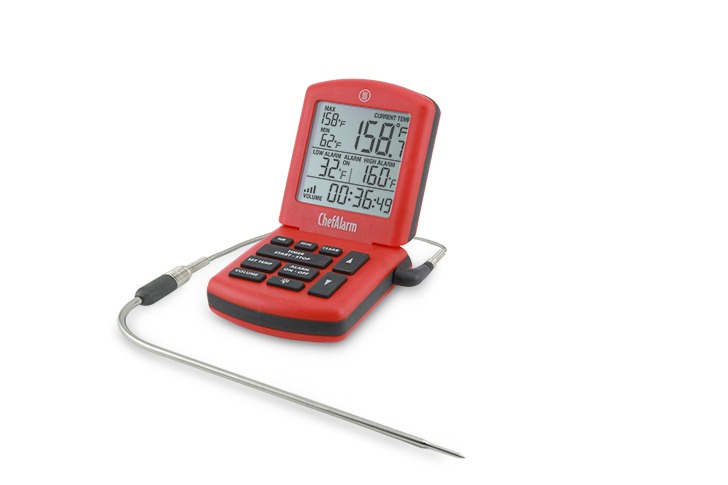

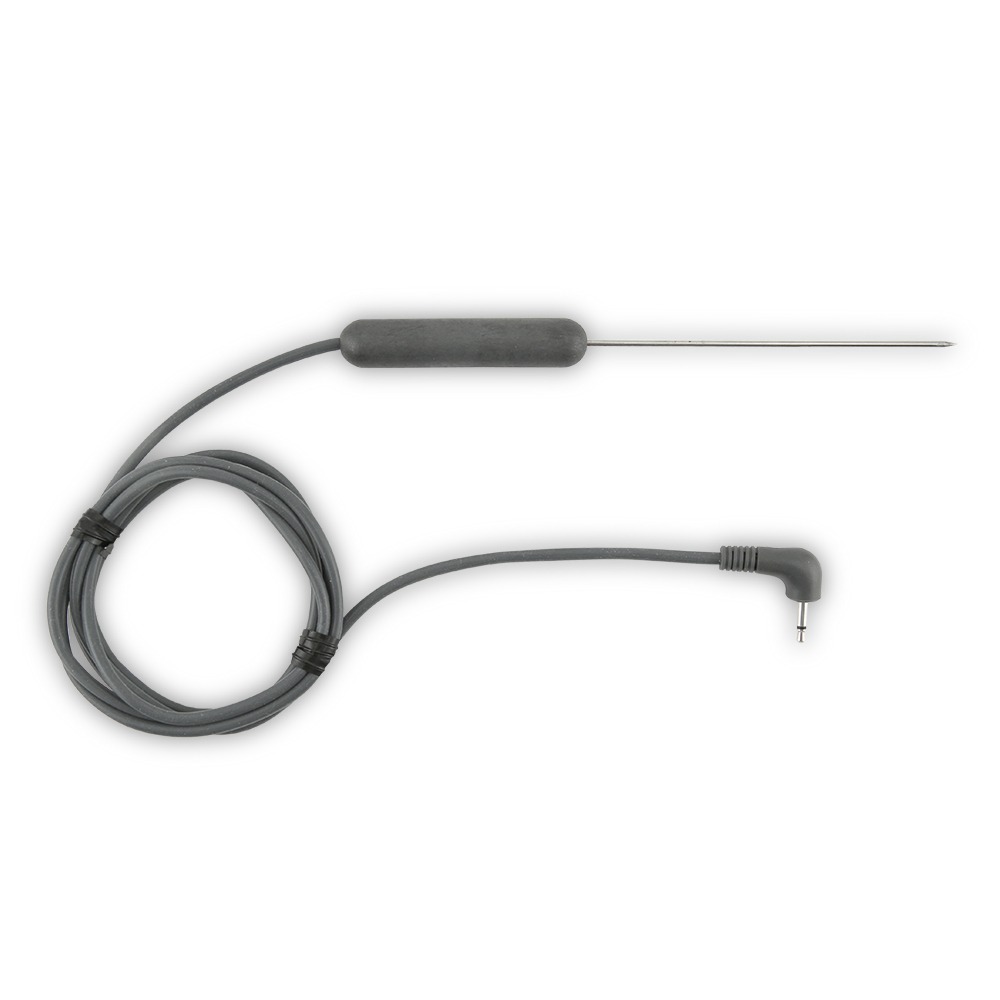
Resource:
Turkey Basics: Safe Cooking, USDA
On Nutrient and Cooking, Harold McGee
Barbecue Turkey and Grilled Turkey, AmazingRibs.com, Meathead Goldwyn
The Food Lab's Guide to Smoking a Turkey, SeriousEats.com, J. Kenji Lopez-Alt
greenhalghblaideselly.blogspot.com
Source: https://blog.thermoworks.com/turkey/turkey-temps/


0 Response to "How Do You Know Turkey Is Done"
Post a Comment